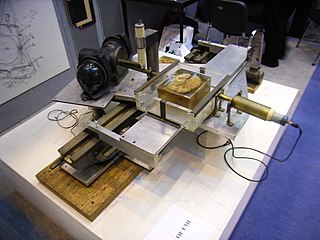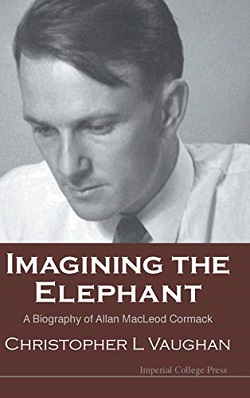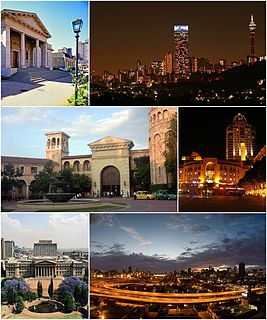
The Cavendish Laboratory is the Department of Physics at the University of Cambridge, and is part of the School of Physical Sciences. The laboratory was opened in 1874 on the New Museums Site as a laboratory for experimental physics. The laboratory moved to its present site in West Cambridge in 1974. As of 2011, 29 Cavendish researchers have won Nobel Prizes. In the Research Excellence Framework the Cavendish Laboratory is ranked as the 7th-equal best physics department in the country.

Mohammad Abdus Salam, was a Pakistani theoretical physicist. He shared the 1979 Nobel Prize in Physics with Sheldon Glashow and Steven Weinberg for his contribution to the electroweak unification theory. He was the first Pakistani to receive a Nobel Prize in science and the second from an Islamic country to receive any Nobel Prize.

University of Frankfurt is a university located in Frankfurt, Germany. It was founded in 1914 as a citizens' university, which means it was founded and funded by the wealthy and active liberal citizenry of Frankfurt. The original name was Universität Frankfurt am Main. In 1932, the university's name was extended in honour of one of the most famous native sons of Frankfurt, the poet, philosopher and writer/dramatist Johann Wolfgang von Goethe. The university currently has around 45,000 students, distributed across four major campuses within the city.

David Jonathan Gross is an American theoretical physicist and string theorist. Along with Frank Wilczek and David Politzer, he was awarded the 2004 Nobel Prize in Physics for their discovery of asymptotic freedom. David Gross is the Chancellor’s Chair Professor of Theoretical Physics at the Kavli Institute for Theoretical Physics of the University of California, Santa Barbara, and was formerly the KITP director and holder of their Frederick W. Gluck Chair in Theoretical Physics. He is also a faculty member in the UC Santa Barbara Physics Department and is currently affiliated with the Institute for Quantum Studies at Chapman University in California. He is a foreign member of the Chinese Academy of Sciences.

George Francis Rayner Ellis, FRS, Hon. FRSSAf, is the emeritus distinguished professor of complex systems in the Department of Mathematics and Applied Mathematics at the University of Cape Town in South Africa. He co-authored The Large Scale Structure of Space-Time with University of Cambridge physicist Stephen Hawking, published in 1973, and is considered one of the world's leading theorists in cosmology. He is an active Quaker and in 2004 he won the Templeton Prize. From 1989 to 1992 he served as president of the International Society on General Relativity and Gravitation. He is a past president of the International Society for Science and Religion. He is an A-rated researcher with the NRF.

James Bertram Collip, was a Canadian biochemist who was part of the Toronto group which isolated insulin. He served as the Chair of the Department of Biochemistry at McGill University from 1928–1941 and Dean of Medicine at the University of Western Ontario from 1947–1961, where he was a charter member of The Kappa Alpha Society.

Atkinson Morley Hospital (AMH) was located at Copse Hill, southwest London, England from 1869 until 2003. The hospital was one of the most advanced brain surgery centres in the world, and was involved in the development of the CT scanner. Following its closure, neuroscience services were relocated to the new Atkinson Morley Wing of St George's Hospital, Tooting.
Amir Ordacgi Caldeira is a Brazilian physicist. He received his bachelor's degree in 1973 from the Pontifícia Universidade Católica do Rio de Janeiro, his M.Sc. degree in 1976 from the same university, and his Ph.D. in 1980 from University of Sussex. His Ph.D. advisor was the Physics Nobel Prize winner Anthony James Leggett. He joined the faculty at Universidade Estadual de Campinas (UNICAMP) in 1980. In 1984 he did post-doctoral work at the Kavli Institute for Theoretical Physics (KITP) at University of California, Santa Barbara and at the Thomas J. Watson Research Laboratory at IBM. In 1994-1995 he spent a sabbatical at the University of Illinois at Urbana-Champaign. He is currently a Full Professor at Universidade Estadual de Campinas. He was the recipient of the Wataghin Prize, from Universidade Estadual de Campinas, for his contributions to theoretical physics in 1986.
GEC Medical was a unit of the General Electric Company that was headquartered in what was known as East Lane Industrial Estate in North Wembley, behind the Hirst Research Centre which fronted East Lane.
William Henry Oldendorf was an American neurologist, physician, researcher, medical pioneer, founding member of the American Society for Neuroimaging (ASN), and originator of the technique of computed tomography.

Makoto Kobayashi is a Japanese physicist known for his work on CP-violation who was awarded one fourth of the 2008 Nobel Prize in Physics "for the discovery of the origin of the broken symmetry which predicts the existence of at least three families of quarks in nature."
Magnus Church of England Academy often abbreviated as 'Magnus', is a British secondary school located in the market town of Newark-on-Trent, in Nottinghamshire, England. It was founded as a grammar school by the 16th century English diplomat and cleric, Thomas Magnus; the original school building, located in Appletongate by the church, is now a small museum.
Christopher L. 'Kit' Vaughan, DSc,, is Emeritus Professor of Biomedical Engineering in the Department of Human Biology, University of Cape Town in South Africa.

The history of X-ray computed tomography goes back to at least 1917 with the mathematical theory of the Radon transform In October 1963, William H. Oldendorf received a U.S. patent for a "radiant energy apparatus for investigating selected areas of interior objects obscured by dense material". The first commercially viable CT scanner was invented by Sir Godfrey Hounsfield in 1967.

Imagining the Elephant: A Biography of Allan MacLeod Cormack is a 2008 biography of physicist and Nobel laureate Allan MacLeod Cormack written by biomedical engineer and author Christopher Kit Vaughan and published by Imperial College Press. The book won the University of Cape Town Book Award in 2010, an honour shared with Nobel laureate J.M. Coetzee who won the award in 1984 for Waiting for the Barbarians.
[3] Oransky, Ivan (2004). "Sir Godfrey N Hounsfield". The Lancet. 364 (9439): 1032. doi:10.1016/S0140-6736(04)17049-9.



















